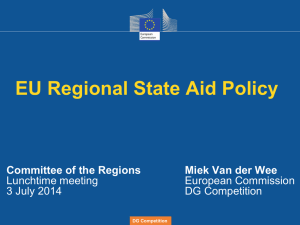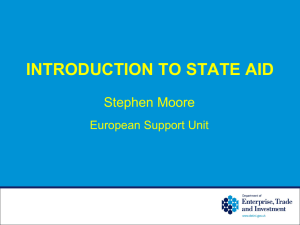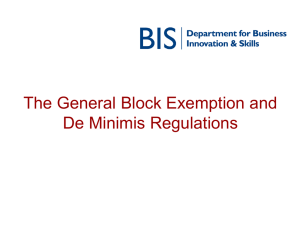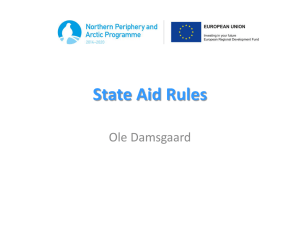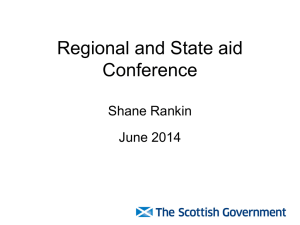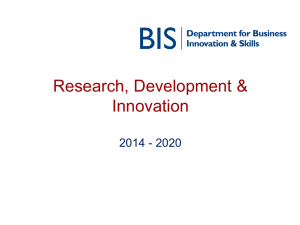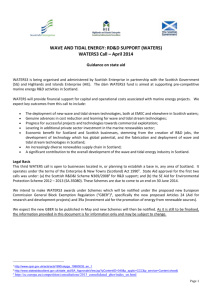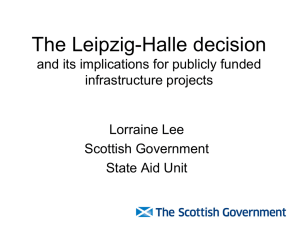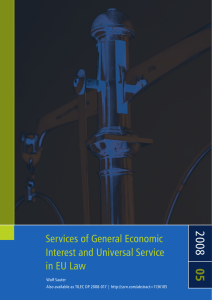No State aid
advertisement
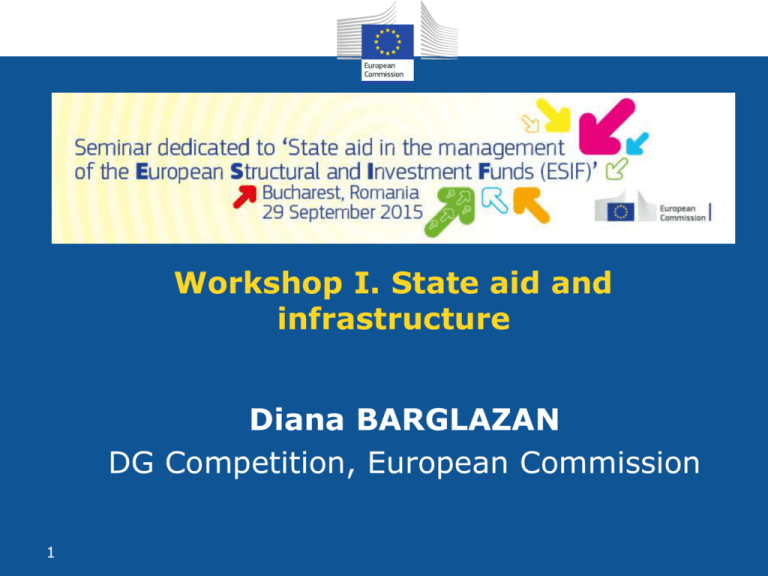
Workshop I. State aid and infrastructure Diana BARGLAZAN DG Competition, European Commission 1 How to Assess Whether Support for an Infrastructure Project Involves State Aid • Notion of aid • Infrastructure assessment grids • Energy infrastructure • Environmental infrastructure • Q&A Notion of aid • State resources • Selective advantage • Undertaking / economic activity • Distortions of competition • Effects on trade Existence of State aid • State resources • Are ESI funds considered State resources? • Selective advantage • Selectivity + Advantage • Undertaking performing economic activity • Type of undertaking is irrelevant • Focus on economic activity • Effect on competition and trade between MS • How about natural monopoly and local monopoly? • How about local undertakings and local activities? State aid can be excluded when… • There are no State resources involved • Funds provided by public undertakings without any influence of the State • Funds provided by international organisations • There is no selectivity • Types of selectivity State aid can be excluded when… • There is no advantage granted • Market economy investor principle • Owner recovers investment + reasonable profit from operator (private co-investors, business plan) • Recovery of full costs or market-conform fee (tender, benchmarking, profitability) • What if the advantage is fully passed on? Advantage - MEIP • Would a market economy investor (MEI) have provided the public funds to the project under the same conditions? • This may be demonstrated by the fact that private co-investors participate to a significant degree to the project on terms and conditions (such as overall risk and return) that are the equivalent to those of the public investor (pari passu). • A sound ex ante business plan showing a return on investment would also be a good indication. Note however that accompanying or prior State aid measures pursuing the same objective invalidate a conclusion that a similar measure would also have been undertaken by a MEI. Altmark criteria If a project and/or its operation is 1. part of a service entrusted as a service of general economic interest (SGEI) and 2. the parameters of compensation have been clearly defined in advance and 3. there is no compensation paid beyond the net costs of the providing the public service and a reasonable profit and 4. the SGEI has been either assigned through a public procurement procedure that ensures the provision of the service at the least cost to the community or the compensation does not exceed what an efficient company would require, then State aid is not involved in the project. State aid can be excluded when… • The beneficiary does not qualify as undertaking (there is no economic activity) • Public remit activities excluded: security, safety, police, customs • Infrastructure that is not commercially exploited: public roads/motorways, public parks/playgrounds Economic activity • The concept of economic activity is defined as offering goods and services on a given market. • If a market, however limited, exists for the activity concerned, then the activity is to be considered economic. • In spite of a decision of an authority to close a market to competition, an economic activity can exist where other operators would be willing and able to provide the service in the market concerned. • The decision of an authority to attribute a certain service to a single company and not to allow third parties to provide it (e.g. because it wishes to provide the service in-house) does not rule out the existence of an economic activity. Non-economic activity (public remit) • Exercise of public powers by the State: exercise of State authority: • • • • maritime traffic control (e.g. Port of Patras - SA.38048) police (e.g. Cruise ship terminal in Wismar - SA.39637) customs (e.g. Port of Katakolo - SA.35738) anti-pollution surveillance (e.g. ECJ Case C-343/95, Cali & Figli v Servizi ecologici porto di Genova) • No remuneration for the use of the access infrastructure (public road, rail) • unless the infrastructure is "dedicated" (e.g. rail tracks and utilities in Seaport extension Wismar - SA.39608) Ancillarity • If the economic activities performed by the infrastructure remain purely ancillary, its funding will fall outside state aid rules (considered as not entailing state aid). • Economic activities will be considered as ancillary if they are: directly related to and necessary for the operation of the infrastructure or intrinsically linked to its main non-economic use, and limited in scope, i.e. the economic activity does not exceed 20% of the infrastructure's overall annual capacity. State aid can be excluded when… • There is no distortion of competition because there is no competition • Not liberalised market: management of railway infrastructure • Competition on the market and competition for the market • How about situations where the decision to liberalize the market are left for the local or regional authorities? Distortion of competition • If the undertaking enjoys a legal monopoly and is confined by the regulatory regime applicable to this activity, and furthermore the market is not liberalised, i.e. not opened up to competition due to EU or national legislation or de facto by market developments, there is no distortion of competition. • If the beneficiary, on the contrary, provides services on any market, the public funding of investments of this beneficiary may qualify as State aid. • Example: the Commission decision N 356/2002 Network Rail State aid can be excluded when… • There is no effect on trade • Activities are purely local and there is no competition for the market open to undertakings from other MS • No presumption: depends on facts = evidence available • Local commercial radius: will beneficiary attract customers from other Member States? – ” Local” more likely for services than goods – Less likely when beneficiary is part of national network • (Potential) impact on investments and establishment must be a) foreseeable (evidence of exchanges in the relevant sector) and b) more than marginal. Effects on trade • Effect on trade are usually present since State aid strengthens the position of an undertaking compared with other companies competing in intra-EU trade. • There is no threshold or percentage below which trade between Member States can be regarded as not having been affected. The relatively small amount of aid or the relatively small size of the recipient undertaking does not a priori mean that trade between Member States may not be affected. • On the other hand, the Commission has in several cases concluded, in the context of the application of State aid rules, that activities had a purely local character and did not affect trade between Member States. Effects on trade • There is no effect on trade • Activities are purely local and there is no competition for the market open to undertakings from other MS Package of 29/5/2015 (IP/15/4889) • Sports/leisure: swimming pool, marinas, outdoors sports centre, community golf clubs • Health care: emergency or « standard » medical services • Culture: venues which do not attract foreign visitors (« destinations in themselves ») • Others: port (Lauwersoog), airport (Isle of Scilly) The Notice on the notion of State aid • Draft for public consultation available at: http://ec.europa.eu/competition/consultations/2014_state_aid _notion/index_en.html • Period of consultation: 17.01.2014 to 14.03.2014 • The notice on the notion of aid is an integral part of the Commission's State aid modernisation (SAM) programme. • The notice intends to provide practical guidance in order to identify State aid measures pursuant to Article 107 (1) of the TFEU, which have to be notified to and approved by the Commission before being lawfully implemented. When is it necessary to notify a State aid measure? • Article 108 (3) TFEU: The Commission shall be informed, in sufficient time to enable it to submit its comments, of any plans to grant or alter aid. • Exceptions: • • • • Individual aid granted under an approved aid scheme De minimis Regulation General Block Exemption Regulation (GBER) SGEI Decision State Aid Legal Framework for the 2014-2020 programming period • Broadband Guidelines (adopted 18.12.2012) (OJ C 25, 26.01.2013) • Regional Aid Guidelines (adopted 19.06.2013) (OJ C209, 23.07.2013) • Risk Finance Guidelines (adopted 15.01.2014) (OJ C19, 22.01.2014) • Aviation Guidelines (adopted 20.02.2014) (OJ C 99, 04.04.2014) • Environmental and Energy Aid Guidelines (adopted 09.04.2014) (OJ C 200, 28.06.2014) • Research & Development & Innovation Framework (adopted 21.05.2014) (OJ C 198, 27.06.2014) • Rescue and restructuring aid Guidelines (adopted 09.07.2014) (OJ C 249, 31.07.2014) State Aid Legal Framework for the 2014-2020 programming period • SGEI: • Communication from the Commission on the application of the European Union State aid rules to compensation granted for the provision of services of general economic interest (OJ C8, 11.01.2012, p. 4-14) • Communication from the Commission, European Union framework for State aid in the form of public service compensation (2011) (OJ C8, 11.01.2012, p. 15-22) • Commission Decision of 20 December on the application of Article 106(2) of the Treaty on the Functioning of the European Union to State aid in the form of public service compensation granted to certain undertakings entrusted with the operation of services of general economic interest (OJ L7, 11.01.2012, p. 3-10) State Aid Legal Framework for the 2014-2020 programming period • General Block Exemption Regulation - Commission Regulation (EU) N.651/2014 (17.06.2014) (OJ L 187, 26.06.2014) • De minimis Regulation - Commission Regulation (EC) N.1407/2013 (18.12.2013) (OJ L 352, 24.12.2013) • Commission Regulation on the application of Articles 107 and 108 of the Treaty on the Functioning of the European Union to de minimis aid granted to undertakings providing services of general economic interest (OJ L 114 of 26.4.2012, p. 8) • Promotion of IPCEI - Compatibility criteria (OJ C 188, 20.06.2014) How to proceed in practice? NO 1. Does the project involve an economic activity? YES No State aid NO 2. Are the other criteria Article 107(1) TFEU fulfilled? • • • State resources/imputability Selective advantage Impact on competition and intra-EU trade Obligation to notify (108(3) TFEU) YES 3. Is GBER or SGEI Decision or the de minimis Regulation applicable? YES Compatible aid – no need to notify • Compatibility analysis • Decision within 2 months from the receipt of a complete notification NO Is there guidance available? • Yes • In general, in case of doubt about the existence of aid or compatibility of the aid in a certain project, Member States can engage in informal discussions with the Commission's services (e.g. pre-notification); • For GBER application, there are procedures meant to provide clarity on the interpretation of the GBER provisions and their possible application to certain projects; • For infrastructure projects, analytical grids have been developed. Varying levels of guidance • Infrastructure is not a uniform notion. • 4 main scenarios in terms of guidance • Specific guidelines (+ GBER): Airports, Energy infrastructure, Broadband • Partial guidance (GBER): Local infrastructure, Sports, Culture and heritage • Well-established case practice: Ports, Rail, … • Evolving case practice: Motorways, Urban transport, Water & Waste water networks What are the Analytical Grids? • Checklists to clarify State aid rules applicable to public funding of infrastructure projects • Grids were developed after a request of COCOF (Coordination Committee of the Structural Funds) in 2012 • In 2012, the Commission (DG REGIO + DG COMP) sent the Grids to Member States • Due to recent developments in SA for infrastructure (new GBER, SGEI, decisions), the Grids have been updated, and some new grids were developed. • New grids were sent to Member States in September 2015 • They do not apply only to projects financed with ESI Funds, but to all infrastructure projects. “Old” Analytical Grids Sector 2012 2015 1. General checklist YES Updated 2. Airports YES Updated 3. Broadband YES YES 4. Culture infrastructures YES Updated (part under culture) NEW 5. Ports YES updated 6. Research infrastructures YES YES 7. Water and waste-water YES YES 4(bis). Sport and multifunctional recreational infrastructures New Analytical Grids Sector 2012 2015 8. Waste management NO Yes 9. Energy NO Yes 10. Rail NO Yes 11. Local public transport NO Yes 12. Motorways / bridges / tunnels (with and without tolls) NO TBD Airports Investment in airport infrastructure generally considered an economic activity when used to provide airport services Compatibility: • SGEI Decision (airports < 200 000 pax) • 2014 Aviation Guidelines • No GBER yet Broadband • Investment in broadband infrastructure is generally considered economic • Compatibility: • GBER Article 52 • 2013 Broadband Guidelines 30 Research infrastructure • Aid insofar as the infrastructure is used to perform economic activities • Compatibility: • GBER Article 26 • RD&I Framework 31 Culture and Heritage • Aid only insofar as the infrastructure is intended activities which are economic (and have an effect on trade) • Compatibility: • GBER Article 53 • TFEU Article 107(3)(d) Sports • Investment in stadia and similar infrastructure may be aid insofar as the facilities are used for an economic activity (and have an effect on trade) • Compatibility: • GBER Article 55 • TFEU Article 107(3)(c) Local infrastructure • Recital 75 GBER "A number of measures taken by Member States with regard to local infrastructures do not constitute aid (…) for example because there is no effect on trade between Member States…" • Compatibility: • GBER Article 56 • TFEU Article 107(3)(c) Ports • Investment in port infrastructure is economic insofar as the infrastructure is intended for the provision of port services to shipping companies against payment; this excludes "public remit" • Compatibility: • SGEI Decision: max 300 000 pax • TFEU Articles 107(3)(c) or 93 (inland ports/intermodal platforms) • No GBER yet Roads & motorways • Investment in toll motorways has in some cases been considered to involve aid; Motorways for free public use are considered as general infrastructure. Road can also be dedicated infrastructure. • Compatibility: • TFEU Article 107(3)(c) (e.g. 2014 Greek Motorways) • TFEU Article 107(3)(b) (e.g. 2014 Oresund ) • SGEI Framework (e.g. French Motorways) Urban Transport Infrastructure • Infrastructure investment has been considered economic where the infrastructure was intended for the provision of transport against payment + effect on trade (SA.34056 – Cable car for London) • Compatibility: • TFEU Article 93 (Cable car for London) Energy infrastructure • Investment in energy infrastructure is generally considered an economic activity • Compatibility: • GBER Article 48 • EEAG Energy infrastructure • How could the aid be excluded? • Advantage * possible MEIP? * possible no aid as the advantage is fully passed on? • No distortion of competition? • Effects on trade * how is the energy infrastructure defined? * could this be the case for local heat infrastructures? Energy infrastructure – case practice • N 197/2008 – Lithuania - RAG sectorial measure for energy • N 54/2009 – Poland - Modernization of heat distribution networks • N467/2009 – Romania - Extension and modernisation of gas and electricity networks in Romania • N629/2009 - Romania - Grants for investment in electricity and natural gas transmission networks • N660/2009 – Poland - Aid to PGNiG for underground gas storage SA.31953 – Poland - Construction of a LNG Terminal in Swinoujsciu • N 419/2009 – Malta – Investments on electricity transmission and interconnector infrastructure • N542/2010 – Poland - Construction of interconnection and cross-border power line between Poland and Lithuania • SA.35695 - Greece - Aid for the interconnection of Cyclades islands with the National Mainland Interconnected Transmission System Water services • Infrastructure directly necessary to suppliers of water services may be held not to be severable from the service provided downstream. • • For instance, the modernisation and extension of network pipelines, sewage and waste water treatment plants connected to households and business all concur to the provision of economic services to end users. • The provision of water services (e.g. drinking/waste water) against payment of a price is an economic activity and, accordingly, the financing of infrastructure which is necessary to supply on a market may involve State aid. Water services • Most relevant aspects: • Effect on trade • Economic activity • Advantage (Altmark / MEIP) Water services – case practice • N 588/2006 NL - Subsidy measure vital Gelderland • The Commission held that subsidy measures benefitting only drinking water companies (owned by local authorities) in the Dutch market, which is not open to competition, did not have the potential to affect competition and trade between Member States. However, measures open to other beneficiaries or concerning industrial water – which was a market open to competition – were found to have such potential. Water services – case practice • N 443/2003 BE - Grey Water Circuits • The Commission analysed investment aid to intermunicipal bodies for sewage plans and distribution networks aimed at providing "grey water" (i.e. purified waste water). • Even if local markets were not subject to competition, the bodies in question could be qualified as "undertakings" and could, at least in theory, be active in other Member States. • The planned subsidies were found to involve (compatible) State aid. Waste infrastructure • Aid insofar as the infrastructure is intended for the provision of waste treatment services against payment • Compatibility: • GBER Article 47 • SGEI Decision • EEAG, section 3.5. Waste infrastructure • A specific analytical grid was developed for waste infrastructure. • Most relevant aspect seems to be: • Advantage • excluded if SGEI and the Altmark criteria are complied with; • or if MEIP (case SA.36591); • or in case open, transparent, non-discriminatory and unconditional tender procedures are used. Wastewater infrastructure • Most relevant aspects seems to be: • Advantage • excluded if SGEI and the Altmark criteria are complied with; • or if MEIP; • or in case open, transparent, non-discriminatory and unconditional tender procedures are used. • Propapier decision (SA 36147): No aid to users when : • Infrastructure is open to all potential users • Fees cover at least the user's incremental costs THANK YOU FOR YOUR ATTENTION! QUESTIONS? Contact: diana.barglazan@ec.europa.eu 49 50
